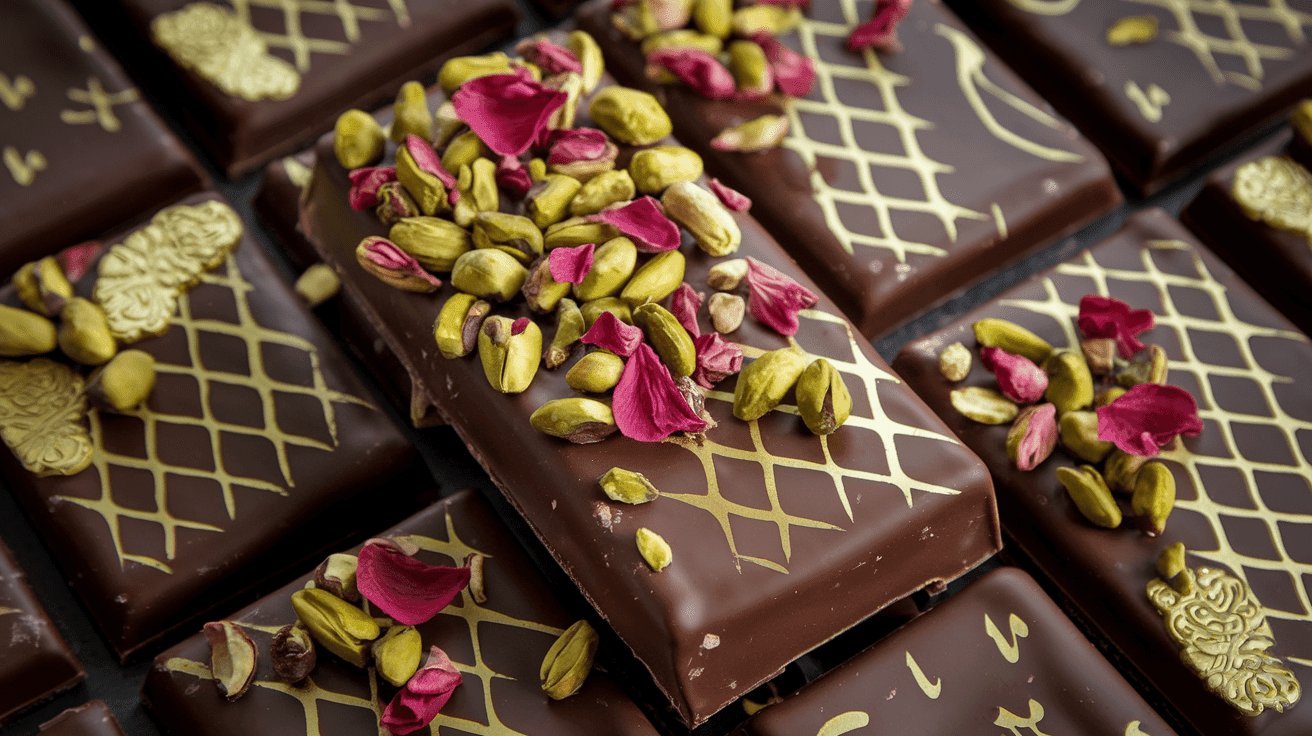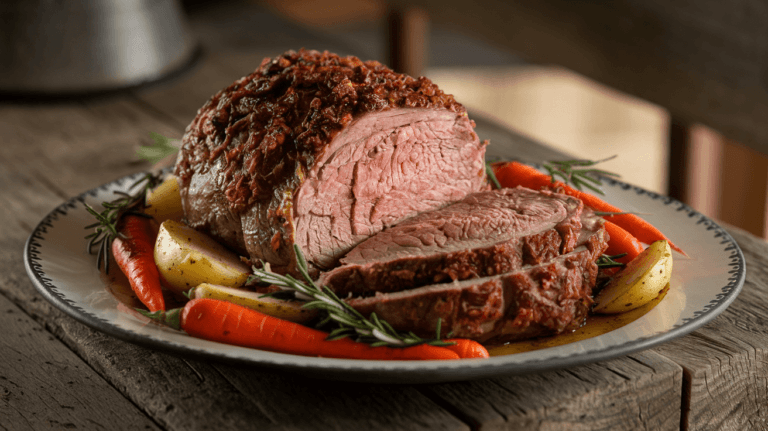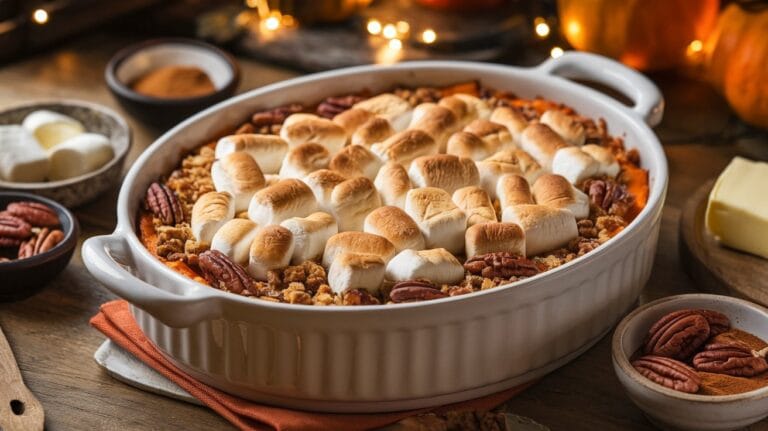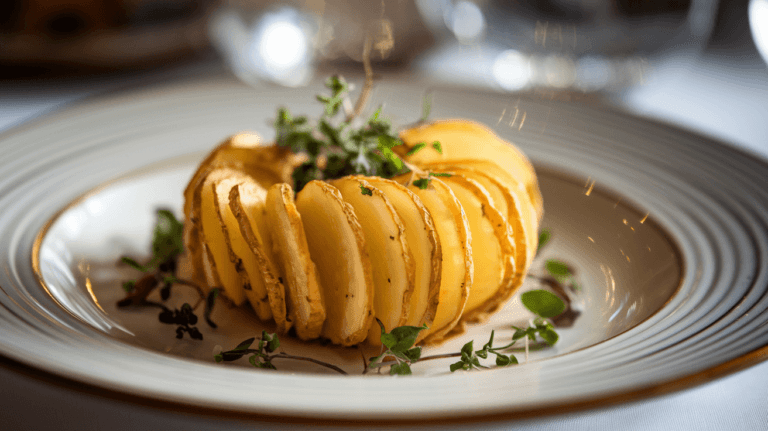Discover how to make an authentic Dubai chocolate bar recipe that combines luxury ingredients with Middle Eastern flavors. Perfect for both beginners and experienced chocolatiers.
Looking to add a touch of Middle Eastern luxury to your chocolate-making adventures? You’re in for a treat! Today, we’ll dive into creating decadent Dubai-inspired chocolate bars that perfectly blend traditional Arabic flavors with premium chocolate. This comprehensive guide will walk you through everything from selecting the finest ingredients to mastering professional tempering techniques, ensuring your homemade chocolate bars rival those found in Dubai’s most exclusive chocolate boutiques.
Table of Contents
Ingredients and Equipment for Dubai Chocolate Bar Recipe
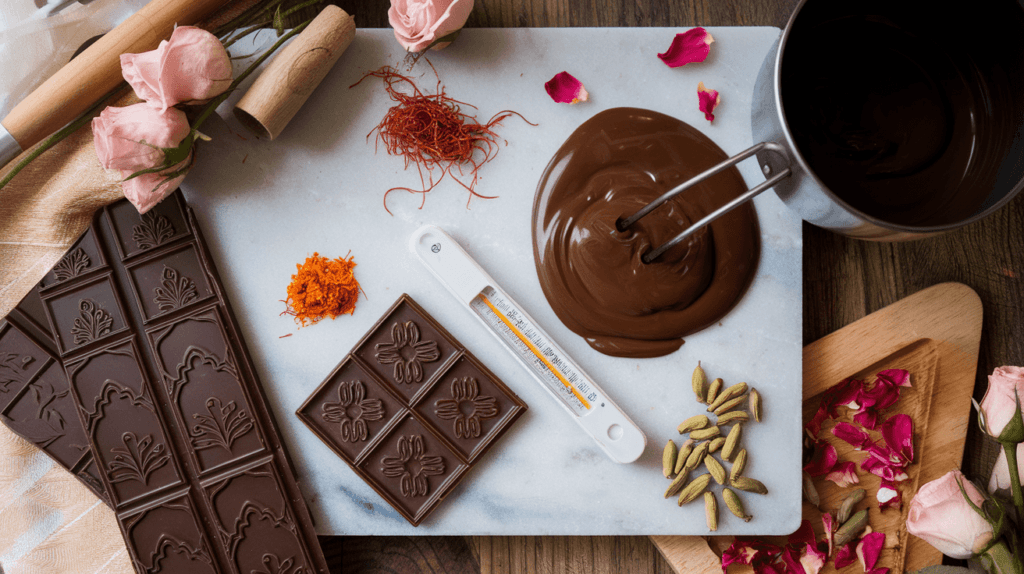
Premium Chocolate Selection
The foundation of any exceptional Dubai chocolate bar starts with selecting the right chocolate. Premium couverture chocolate with 65-70% cocoa content is ideal for this recipe. Look for brands that specialize in Middle Eastern chocolate making, or opt for well-known European varieties that offer smooth texture and rich flavor profiles. The secret lies in using chocolate with a high cocoa butter content, which ensures proper tempering and that signature snap when broken.
Traditional Middle Eastern Flavoring Ingredients
What sets a Dubai chocolate bar apart is its unique fusion of flavors. You’ll need:
- Premium ground cardamom
- Iranian saffron threads
- Rose water (preferably from Damascus)
- Crushed pistachios from Iran or Turkey
- Date powder or premium Medjool dates
- Orange blossom water
- Ground Omani frankincense (optional for aromatic enhancement)
Essential Equipment
Creating professional-quality chocolate bars requires specific tools:
- Digital thermometer (crucial for tempering)
- Double boiler or bain-marie setup
- Silicone chocolate bar molds (preferably with traditional Arabic patterns)
- Offset spatula
- Microplane grater for spices
- Fine mesh strainer
- Heavy-bottom saucepan
- Marble slab or granite countertop (for tempering)
Storage and Packaging Materials
Proper storage is essential for maintaining quality:
- Airtight containers
- Wax paper
- Food-grade silica gel packets
- Gold foil wrappers (for authentic Dubai presentation)
- Decorative boxes with Arabic motifs
The key to success lies in preparation. Before starting, ensure all equipment is thoroughly cleaned and completely dry – even a drop of water can cause chocolate to seize. Arrange your ingredients in order of use, and maintain a cool room temperature (around 20°C/68°F) for optimal working conditions.
A note about temperature control: Dubai’s climate presents unique challenges for chocolate making. If you’re working in a warm environment, consider setting up a cooling station with ice packs nearby or working in an air-conditioned space to maintain ideal chocolate temperatures throughout the process.
When selecting your main chocolate, consider that dark chocolate works best for highlighting the subtle notes of cardamom and saffron, while milk chocolate pairs beautifully with dates and pistachios. For a truly authentic experience, some Dubai chocolatiers recommend blending both types to create a unique base that carries the complexity of flavors we’re aiming for.
Remember, the quality of your ingredients will directly impact your final product. While premium ingredients might seem costly initially, they’re essential for achieving that luxury Dubai chocolate experience. Each component plays a crucial role in creating not just a chocolate bar, but a piece of edible artistry that reflects Dubai’s reputation for excellence and opulence.
The preparation of these ingredients requires attention to detail:
- Toast and finely grind pistachios just before use to ensure maximum freshness
- Crush cardamom pods and sift to remove husks
- Steep saffron in warm (not hot) cream for optimal flavor extraction
- Process dates until they form a smooth paste for even distribution
By taking time to properly source and prepare these ingredients, you’re setting yourself up for success in creating chocolate bars that truly capture the essence of Dubai’s legendary confectionery scene. In our next section, we’ll dive into the precise tempering techniques that will give your chocolate bars that professional finish and satisfying snap.
The Art of Tempering for Dubai Chocolate Bar Recipe
Understanding the Science of Tempering
The secret to creating professional-quality Dubai chocolate bars lies in proper tempering. This crucial process ensures your chocolate has that coveted glossy finish and satisfying snap characteristic of luxury Middle Eastern confections. Tempering is all about controlling the crystallization of cocoa butter, which requires precise temperature control and careful manipulation.
Tempering chocolate involves heating it to specific temperatures:
- Dark chocolate: Heat to 45°C (113°F), cool to 27°C (81°F), then warm to 31-32°C (88-90°F)
- Milk chocolate: Heat to 42°C (108°F), cool to 26°C (79°F), then warm to 29-30°C (84-86°F)
- White chocolate: Heat to 40°C (104°F), cool to 25°C (77°F), then warm to 28-29°C (82-84°F)
Remember that patience is key during this process. Rushing the tempering stage can result in chocolate that lacks shine and proper texture. Professional Dubai chocolatiers often spend years perfecting their tempering technique, so don’t be discouraged if your first few attempts aren’t perfect.
Traditional Dubai Tempering Methods
While modern chocolate makers often use tempering machines, traditional Dubai chocolate artisans prefer the hand-tempering method using a marble slab. This technique, though more challenging, offers greater control and connection to the craft. Here’s the process:
- Begin by melting your chocolate using a double boiler
- Pour about 2/3 of the melted chocolate onto the marble slab
- Work the chocolate with a spatula, spreading and gathering repeatedly
- Monitor the temperature constantly using your digital thermometer
- When properly cooled, return the chocolate to the remaining warm chocolate
- Stir until completely combined and at the perfect working temperature
Adding Middle Eastern Flavors and Textures
Incorporating Traditional Arabic Spices
What transforms an ordinary chocolate bar into a Dubai chocolate bar is the masterful incorporation of Middle Eastern flavors. The key is to add these elements at precisely the right moment during the tempering process to ensure even distribution without compromising the chocolate’s texture.
For the signature Dubai flavor profile, consider these combinations:
- Cardamom and rose: Add finely ground cardamom (1/4 tsp per 500g chocolate) and 2-3 drops of rose water
- Saffron and pistachio: Infuse cream with saffron before adding to chocolate, fold in crushed pistachios
- Date and orange blossom: Incorporate date paste (30g per 500g chocolate) with a hint of orange blossom water
Creating Texture Layers
Texture plays a crucial role in elevating your Dubai chocolate bars. Professional chocolatiers recommend working in layers:
First Layer:
- Pour a thin layer of tempered chocolate into molds
- Allow to set partially (about 2 minutes)
Middle Layer:
- Add your spiced ganache or flavor-infused chocolate mixture
- Ensure even distribution
- Let set until just firm
Final Layer:
- Cap with remaining tempered chocolate
- Tap molds gently to remove air bubbles
- Scrape excess for clean edges
The secret to achieving the perfect texture lies in timing. Each layer should be added when the previous one is just beginning to set but still slightly tacky. This ensures proper bonding between layers while maintaining distinct texture profiles.
Remember to consider the humidity levels when working with your chocolate. Dubai’s climate can be challenging for chocolate making, so maintaining a controlled environment is crucial. Use a dehumidifier if necessary, and avoid making chocolate on particularly humid days.
When incorporating nuts or other solid ingredients, they should be thoroughly dried and at room temperature to prevent moisture from affecting the chocolate’s texture. Many Dubai chocolate makers toast their nuts and spices first, not only to remove excess moisture but also to enhance their flavors.
For advanced texture combinations, consider:
- Creating a praline layer with crushed pistachios
- Adding a thin layer of date caramel
- Incorporating crushed baklava pieces for extra crunch
- Sprinkling sea salt flakes for contrast
The beauty of making Dubai-style chocolate bars lies in finding the perfect balance between traditional Middle Eastern flavors and modern chocolate-making techniques. Each element should complement rather than overpower the others, creating a harmonious blend that tells the story of Dubai’s rich culinary heritage through every bite.
Molding and Decorating Dubai Chocolate Bar Recipe
Creating the perfect shape for your Dubai chocolate bars requires attention to detail and proper technique. First, ensure your molds are immaculately clean and at room temperature. Many professional chocolatiers in Dubai polish their molds with cotton wool between uses to achieve that signature high gloss finish.
To achieve professional results:
- Polish molds with cotton wool until they shine
- Pre-warm molds slightly (around 27°C/80°F) to prevent shock
- Pour tempered chocolate at the ideal working temperature
- Tap molds firmly to remove air bubbles
- Scrape excess chocolate cleanly using a metal scraper
- Allow to set at room temperature (avoid refrigeration)
Traditional Arabic Decorative Elements
The visual appeal of Dubai chocolate bars often comes from their intricate decorative elements that reflect Islamic geometric patterns and Arabic calligraphy. Consider these traditional decorative techniques:
- Use transfer sheets with Arabic patterns
- Dust with edible gold powder (a Dubai favorite)
- Create geometric designs using colored cocoa butter
- Incorporate traditional Arabic script motifs
- Add subtle shimmer with pearl dust
Remember to apply any decorative elements while the chocolate is still wet for proper adherence. Many Dubai chocolate makers recommend practicing these techniques on parchment paper before attempting them on your actual chocolate bars.
Packaging and Storage for Dubai Chocolate Bar Recipe
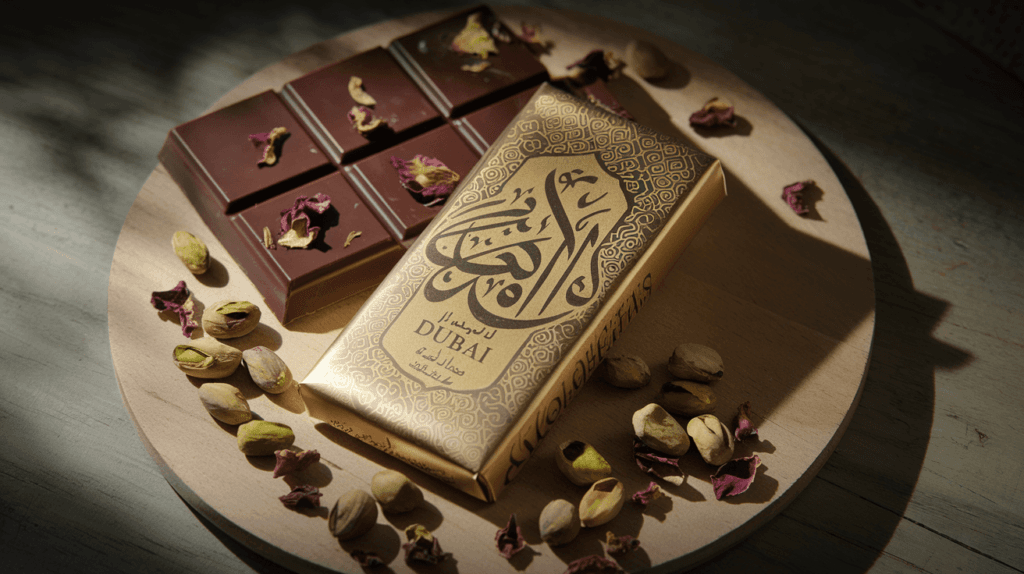
Professional Packaging Methods
The presentation of Dubai chocolate bars is just as important as their taste. Traditional Dubai chocolate packaging often reflects the luxury and sophistication of the region. Here’s how to package your chocolates professionally:
- Allow bars to completely set (minimum 24 hours)
- Handle with clean, dry hands or wear gloves
- Wrap first in gold foil
- Add a protective layer of wax paper
- Place in decorative boxes with Arabic-inspired designs
- Include storage instructions and ingredients list
Proper Storage Techniques
Storing your Dubai chocolate bars properly is crucial for maintaining their quality and appearance. The ideal storage conditions are:
Temperature: 18-20°C (64-68°F) Humidity: Below 55% Light: Away from direct sunlight Air: In airtight containers
For best results:
- Store in a cool, dark place
- Use food-grade silica gel packets to control moisture
- Keep away from strong odors
- Avoid temperature fluctuations
- Consider using a wine cooler set to the proper temperature
Professional Tips and Industry Secrets
Expert Techniques from Dubai Chocolatiers
Leading chocolate makers in Dubai have developed unique methods to achieve excellence in their craft. When creating Dubai chocolate bars, these professionals emphasize the importance of timing and technique. Many master chocolatiers start their work in the early hours of the morning when the temperature and humidity are most favorable for chocolate work.
Key professional insights include:
- Pre-crystallizing chocolate before major holidays
- Using marble surfaces chilled with ice packs underneath
- Maintaining multiple tempering stations at different temperatures
- Creating signature spice blends unique to each chocolatier
Advanced temperature control methods:
- Using infrared thermometers for surface temperature
- Installing humidity-controlled work stations
- Developing cooling chambers with precise settings
- Implementing zone-specific climate control
Quality Control Measures
Professional Dubai Chocolate Bar Recipe undergo rigorous quality checks throughout production. Here’s what the experts look for:
Visual Inspection:
- Even color distribution
- Absence of bubbles or streaks
- Clean, sharp edges
- Consistent shine
Texture Assessment:
- Clean snap when broken
- Smooth mouthfeel
- Proper crystal formation
- Even melting point
Sustainability and Sourcing
The best Dubai Chocolate Bar Recipe start with responsibly sourced ingredients. Modern chocolate makers in Dubai are increasingly focusing on sustainability while maintaining luxury standards.
Key considerations include:
- Working with certified cocoa suppliers
- Supporting local date farmers
- Sourcing spices from traditional markets
- Using organic ingredients when possible
Sustainable practices:
- Reducing packaging waste
- Implementing energy-efficient production methods
- Supporting fair trade initiatives
- Using local ingredients when possible
Environmental Considerations
Creating luxury chocolate while being environmentally conscious requires careful planning:
Energy Management:
- Using energy-efficient equipment
- Implementing solar power where possible
- Optimizing production schedules
- Reducing water usage
Waste Reduction:
- Composting organic waste
- Recycling packaging materials
- Reusing water from cooling systems
- Minimizing plastic use
Temperature control solutions:
- Passive cooling systems
- Solar-powered climate control
- Thermal insulation improvements
- Energy-efficient storage solutions
Many Dubai chocolate makers are now leading the way in sustainable luxury chocolate production. They’re proving that high-end confectionery can coexist with environmental responsibility. Through careful sourcing, efficient production methods, and thoughtful packaging choices, these artisans are setting new standards for sustainable chocolate making in the Middle East.
Advanced producers often create partnerships with:
- Local farms for fresh ingredients
- Sustainable packaging manufacturers
- Energy efficiency consultants
- Waste management specialists
Remember that sustainable chocolate making isn’t just about environmental impact – it’s also about preserving traditional methods and supporting local communities. Many Dubai chocolatiers work closely with local suppliers to maintain the authentic character of their products while reducing their carbon footprint.
If you’re looking for more tasty recipes, check out our collection of delicious meal ideas!

